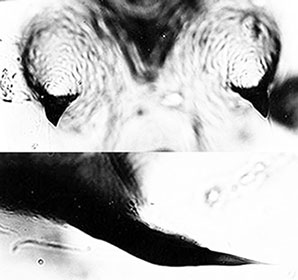
Fourth instar Larva a small plumosus-type; length about 10.9 (8.0-12.0 mm). Anterior ventral tubules (1.12-1.68) shorter than posterior pair 1.26-2.2). Anal tubules about 370.5 (304-520) µm long and 2.4-6 times longer than wide - those from California (abt. 520 x 140 µm) much longer than those from Mississippi or Texas (321 x 126 µm).
Pale gular and frontoclypeus. Salivary reservoir about 80 (71-94) µm long and about 4-6 times longer than deep.
.
Mentum (Fig. c) with pointed teeth when not worn; c1 tooth moderately broad, c2 teeth well developed and sharp pointed (i.e. type IB-III); 4th laterals at least slightly reduced (type I-II) but occasionally ty. III.
Ventromentum (Fig. d) separated by about 0.25-0.32 of the mentum width; about 194 (182-204) µm wide and 3.5-3.74 times wider than deep; 1.06 (1-1.12) times the mentum width; with about 42 (40-44) striae; VMR 0.25 (0.23-0.27). Pecten epipharyngis (Fig. a)with about 15 long tapering teeth.
Antenna (Fig. b) with basal segment quite long, abt 3.7 times longer than wide, abt 4 times the length of A2 and a third to a half the VHL; Ratio of antennal segments 124 : 34 : 9.5 : 12.5 : 7 ; AR about 1.99 (1.83-2.12); A1 about 4 times longer than wide; ring organ toward center of the segment.
Distance between antennal bases (170 (142-205) µm) mostly greater than that between the S4 setae (164 (144-190) µm), which are separated by about 83% of the Frontoclypeus width at that point.
Mandible (Fig. e) with third inner tooth only partly darkened (generally type IIB); about 15.5 (13-18) furrows on outer surface at the base; 10.6 (8-12) taeniae in Pecten mandibularis; Mdt-Mat abt 15-25 µm; MTR abt 0.25 (0.21-0.32).
Pupa: Total length 5.64-6.22 mm (male); 6.44-6.66 (female); inner margin of the wing case (male) 1.50 mm. Integument infuscate with darker stripe extending to the postero-lateral spur, anal lobe dark. Cephalothorax with coarse tubercles along both sides of the median raphe. Tergum II with 62-84 recurved hooks. Terga II-VI with coarse shagreen over most of the surface; tergum VII with finer shagreen in the basal half; tergum VIII with fine shagreen towards the lateral margin.
Cephalic tubercle (male) 63x53 µm. Respiratory base about 128x67 µm., HR 1.85-1.96.
Pedes spurii A on segment IV 131.5-146.7 µm long, 88.5 µm wide, 0.19-0.21 of segment length; that of segment V comprised of spines.
Caudolateral spur of segment VIII usually with only 1, but occasionally 2 or 3 weaker spines at the end. Fringe of anal lobe 68-99 flattened marginal taeniae, in 2-3 rows anteriorly, single row posteriorly.

Cytology: 4 polytene chromosomes with the pseudothummi arm combination AE, BF, CD, G.
Arm G paired with a virtually terminal nucleolus at one end and two Balbiani rings, seperated by dark bands near the other end. The more distal BR is almost terminal in Mississippi populations due to an inversion, apparently as in C. columbiensis. No nucleoli in the long chromosomes.
Inversion polymorphism occurs in arms D, F and G, although no heterozygotes have been found for the inversions in arms F and G. Two inversions occur in arm D, a short proximal one in California populations, and a distal one in Texas and Mississippi.
anyA1: 1a - e, 12 - 10, 4 - 9, 2d - 3b, 2c - 1f, 3c-i, 13 - 19
anyB1: Puff (group 7) about 1/3 from distal end.
anyC1:
anyD1:
anyE1: 1a - 2e, 9a - 10b, 3e-a, 8i - 3f, 10c - 13g
anyF1: 1a-i, 16 - 19d, 6b - 2, 15 - 14, 12 - 13, 6c - 11, 20 - 23 (Texas, Mississippi), as columbiensis
anyF2: 1a-b, 2b - 6b, 19d - 16, 1i-c, 2a, 15 - 14, 12 - 13, 6c - 11, 20 - 23 (California)